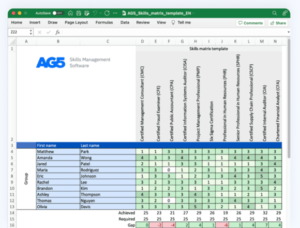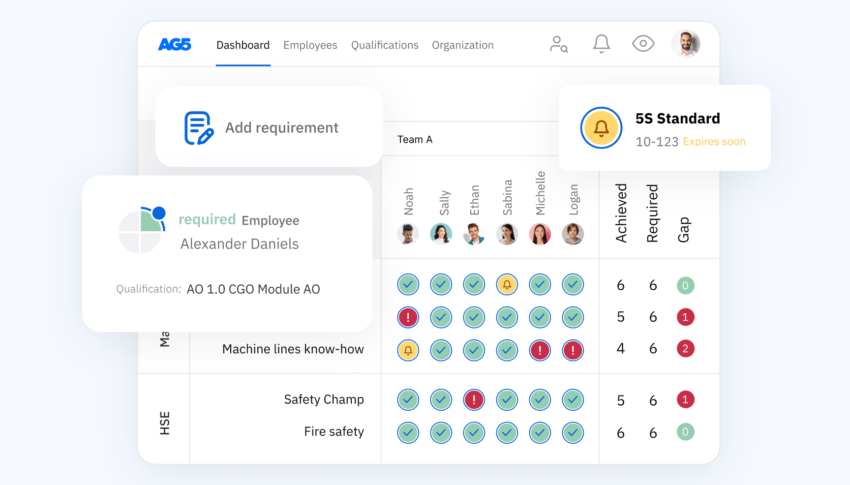Our Marketplace Spotlight series focuses on the partners making the Yocova platform come alive and the digital aviation solutions they provide. In this issue, we focus on award-winning skills management software company AG5, and their tips for overcoming complex skills management challenges.
In this article, AG5 will take you through everything you need to know about skills mapping, how it can benefit you, and how to implement it for best effect. Once you have the information you need, you can use it to lay a foundation for skills management.
What is skills mapping?
Skills mapping is a visual representation of all your employees’ skills. It involves analysing the skills that are required to fill a given role, perform a certain task, complete a project, or round out a team.
Skills mapping can be applied to an organization as a whole, but also departments, teams, or specific disciplines. By using skills mapping, you are better able to see what each employee brings to the table, in terms of strengths and weaknesses.
What are the benefits of skills mapping?
According to the World Economic Forum:
66% of organizations are using some form of skills mapping to ensure that their employees and teams have the skills they need to navigate uncertainty.
Source: The Future of Jobs Report 2020 | World Economic Forum (weforum.org)
Such a statistic is an indicator of the many benefits of skills mapping to organizations. Let’s take a look at them:
- Skills mapping pinpoints the tasks and skills that are crucial to your organization.
- Skills mapping highlights the employees who can benefit from additional training.
- You can identify your most valuable employees, as well as specialists and generalists.
- You can find suitable replacements for employees off sick – or HR can create a candidate profile to replace an employee who is leaving your company.
- You can track skills-related progress for your organization’s departments, teams, and individuals.
 How to make a skills map.
How to make a skills map.
So how does skills mapping work in practice? The best way to visualize proficiency levels is by using skills matrices.
A skills matrix is exactly what its name suggests – a snapshot of all your employees’ skills laid out in matrix form.
Generally speaking, you create one skills matrix for each department or team. Then, you list all your employees’ names, or their roles, down the left-hand column and all their skills across the top row (or vice versa). Next, you enter the proficiency levels for each employee for each skill until you’ve filled your matrix.
Different types of skills in a skills map
Before you start creating a skills matrix, it’s important that you understand the types of skills you may need to visualize. Here we discuss three of the most common types of skills that our customers use skills matrices to track.
- Technical skills. Technical skills consist of the specific, practical – sometimes specialized – skills that employees need for their roles. In the manufacturing industry, for example, these might include skills related to machine operation, quality assurance, or automated manufacturing systems.
- Soft skills. Employees’ communication, teamwork, and problem-solving skills (among others) will also be important when building teams.
- Leadership skills. By visualizing skills related to conflict resolution, project management, strategic thinking, and resource allocation, you can easily identify employees with high potential for leadership roles.
Challenges in skills mapping
Skills mapping is undeniably beneficial, but it can also present challenges for organizations seeking to implement it. Let’s take a quick look at a few of these challenges, as well as how you can navigate them.
- Skill dynamism. The need for certain skills – as well as the nature of skills themselves – will evolve along with technologies, regulatory changes, and industry advancements. You’ll need to constantly and consistently update your skills matrices to ensure they stay up to date.
- Data accuracy and currency. You’ll also need to ensure that the data you use to create your skills map stays up to date and accurate, and consistently update your skills maps or matrices.
- Lack of standardization. Without a standardized method of skill assessment, there may be inconsistencies in the way your departments in teams categorize, assess, and measure proficiencies. You’ll need to ensure that all members of the organization who work or manage skills maps are aligned.
Skills mapping tips
Realizing the full benefits of skills mapping means implementing and using it most effectively. Here are a few tips for getting started with skills mapping.
- Start with a skills assessment
Before you can determine proficiency levels, you should define the skills you want or need to assess. This means the first step you’ll need to take is to perform an assessment to map your employees’ skills.
- Don’t add too many people to one matrix
The biggest advantage of skills mapping is the clarity it provides – so divide and conquer! Split your employees into teams or departments and select the skills relevant to each. We also suggest creating separate skills matrices for soft and hard skills.
- Stick to the most important information
The possible uses for skills matrices are virtually limitless, but don’t make them more complex than they need to be. To maintain clarity, stick to the most important skills, competencies, tasks, and qualifications for each position.
- Use skills management software
Many organizations often initially use spreadsheets to create their skills matrices, but this isn’t always the best long-term solution. Spreadsheets quickly become overly complex and are extremely error prone. They also cause a great number of version management headaches. Fortunately, there are special-purpose solutions available, such as AG5’s skills management software.
Start skills mapping with AG5’s skills management software
AG5’s skills management software is a one-stop solution for skills management across your organization. Using the platform:
- Your skills mapping efforts will be directly transformed into intuitive skills matrices that are always accurate and relatable
- All skills-related information can be accessed and updated quickly, easily, and directly from the work floor.
- You’ll have access to a standardized method of skill assessment and tracking that is automatically updated in real time.
- And much more.
Want to see how AG5 would work in your organization?
Visit their Yocova storefront today and book a demo.



